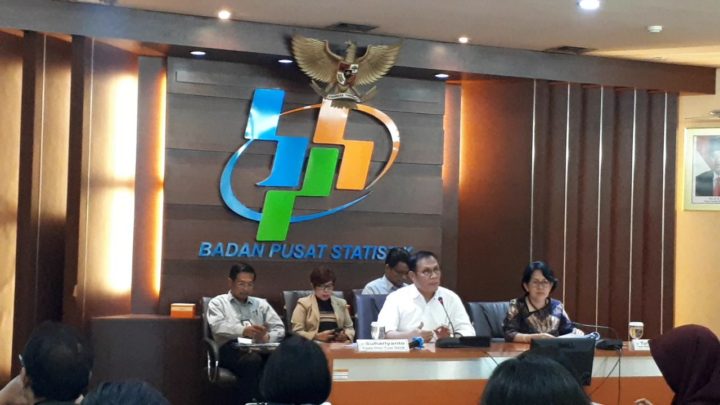
In March 2018, the Central Statistics Agency (BPS) released a poverty figure which showed a decline of 1.82 million people compared to March 2017.
Through June 2018, the annual inflation rate was only 3.12 percent, lower than the 3.61 percent inflation in the first half of 2017. In fact, in June, monthly inflation was only 0.59 percent, although the highly consumptive Idul Fitri holiday fell during that month.
Keeping the inflation rate at a relatively low or stable is important for the economy. Low inflation can reduce lending interest rates. More efficient financing will reduce the high-cost economy so that productivity will improve. Conversely, high inflation will further reduce purchasing power and undermine the people's welfare.
As of the first quarter, household consumption grew only 4.95 percent, lower than the 4.97 percent during the same period in 2017. Although it only fell 0.02 percent, this figure should not be ignored. Household consumption contributes about 56.8 percent to the national income. This condition is likely to continue. In the May-June period, the average increase in retail sales was 4 to 5 percent year-on-year.
At first glance, an anomaly appeared to exist between the relatively low inflation and low purchasing power. The relatively low inflation was not due to an increase in supply or an improved cost efficiency in production. The availability of food supplies during the highly consumptive Idul Fitri holiday was supported by imports in April-May.
The deflation in several food commodities, such as rice, garlic and shallots, was due to imports. However, farmers complained because the price of unhusked rice fell during the harvest season. Farmers' incomes declined, which resulted in a fall in their purchasing power.
Risks
The low inflation that has not caused any impact on productivity and purchasing power should be thoroughly scrutinized. If this pseudo inflation is ignored, it would bring multiple impacts on the economy.
First is stagnation in economic growth. If the low inflation was caused by a decline in demand, it would place a heavy burden on the economy. Moreover, the contribution of household consumption to economic growth rose from 56.13 percent in 2017 to 56.8 percent in the first quarter of 2018. With a bigger contribution but lower growth, the role of household consumption has weakened as the main driver of economic growth.
Second, the industrial sector will be undermined. The weak growth in household consumption could cause sluggish growth in the industrial sector. Investors will place their funds in low-risk business sectors that deliver high yields. Investors will avoid the industrial sector. Capital will flow only to investment portfolios. The money in hot short-term funds could increase risks to financial sector stability.
Third, job opportunities will fall. The collapse of the industrial sector, mainly due to deindustrialization, is prone to layoffs. Although it will not increase open unemployment, the number of informal workers would increase. The number of informal workers increased significantly from 69.02 million in August 2017 to 73.98 million in February 2018.
Fourth, farmers' welfare will decline. The fall in food prices in June 2018 caused a decline in farmers' welfare. Even though the Farmers Exchange Rate (NTP) increased 0.05 percent to 102.04 in June 2018, food inflation remained high at 0.88 percent.
Fifth is the trade deficit. The high import volume, due to the price stability program during Idul Fitri, caused a trade deficit of US$1.63 billion in April and $1.53 billion in May. Although exports in April and May increased respectively to $14.5 billion and $16.2 billion, the increase in imports was unable to meet the need, which totaled than $17 billion in May.
Sixth is the polemic on poverty reduction. In March 2018, the Central Statistics Agency (BPS) released poverty data that showed a decline of 1.82 million poor people compared to March 2017. The number was somewhat higher than in previous years. Unfortunately, food expenditure remained very high at 76.66 percent in rural areas and 71.04 percent in urban areas. It thus indicated that quality of life had not improved, as purchasing power for non-food products remained low.
Meeting the 2,100-calorie daily dietary requirement as the poverty line indicator was primarily due to the "success" of government programs. In the first quarter, the government's cash social assistance grew 87.6 percent, while the distribution of subsidized rice for the poor (ranstra) and non-cash food aid (BPNT) reached 99.6 percent. It is feared that if the social assistance and ranstra programs are stopped, the vulnerable poor will again descend below the poverty line.
Efforts to control price should not be undertaken only to keep the inflation figure low. Price stability should be followed by increased productivity and purchasing power. To that end, the role and function of local administrations and the regional inflation control team (TPID) should be optimized. The TPID should not only monitor inflation, but also prevent and control regional inflation. The TPID's recommendations should prompt local administrations to carry out anticipatory measures.
Through commodity balances, each region can map out food clusters to anticipate the potential surplus and deficit of important regional commodities. Streamlining commodity balances with a national food price information system will encourage interregional trade and help smooth food distribution.

Tidak ada komentar:
Posting Komentar